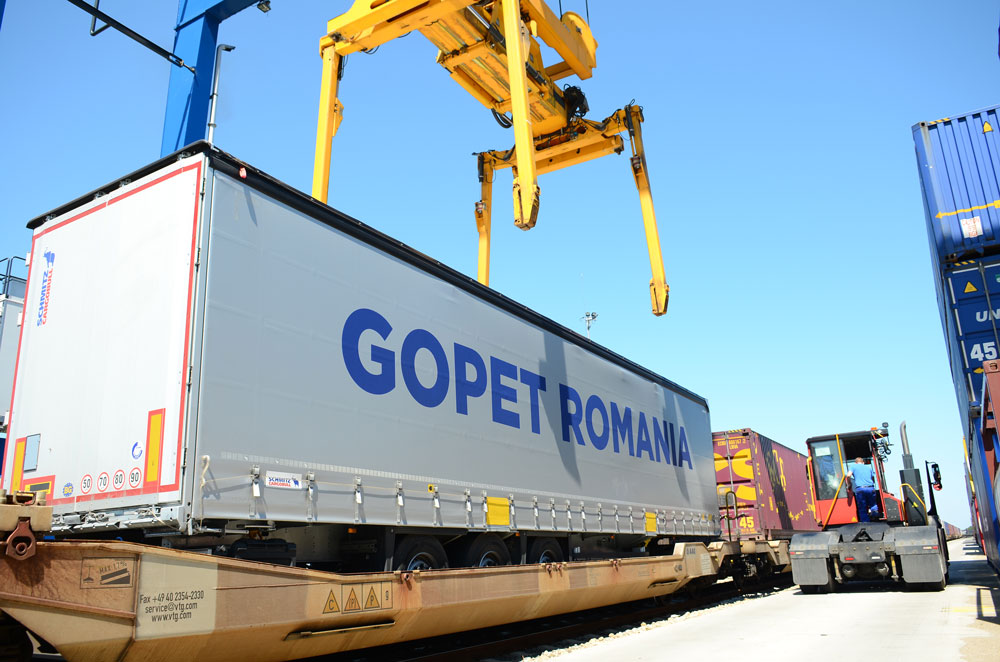During the last couple of years, we have noticed a transformation in customers’ perception in relation to the European continental intermodal transport solutions, says Dan Suciu, Intermodal Manager at GOPET Romania. Now, the customers understand the long-term advantages even better, and capacity being the most important factor among them all.
“We are talking about two types of capacities here: one is covering volumes in the peak season, during the weather restrictions, and import-export imbalances of road transport; second regarding the specific capacity, loading dangerous goods and the possibility of loading higher payloads. The law allows a 2-axle vehicle with a 3-axle semi-trailer, within intermodal transport operations, a maximum total allowable weight of 42 tons”, explains Dan Suciu.
At the same time, he continues, flexibility has become a well-known factor of the intermodal transport. And this as a result of rise of the weekly trains’ frequency, optimisation of transit times due to high-performance engines, and new sets of wagons, as well as increasingly efficient terminals.
In this context, customers from different industries such as agribusiness, metallurgy, chemical, plastics, automotive, components, tires, wood or FMCG have introduced and significantly increased the share of intermodal solutions in the services requested via tenders.
Volume increases for GOPET Romania in the first part of 2021
Compared to the previous year, 2020 has brought for GOPET Romania stagnation in annual volumes. Nonetheless, during quarters some significant fluctuations have been noticed, especially in the first half of the year, when some customers reduced their production due to the imposed restrictions, while others have been looking for alternative transport solutions due to border situations and declining truck fleets in Europe.
“Volume fluctuations and lack of forecasts made it difficult to organise efficient intermodal transports. We deal with committed seats on trains throughout the whole year and we work together with long-term subcontracted carriers at each terminal, to whom we must provide a minimum of kilometres per month”, says Dan Suciu.
Despite the many challenges of 2020, including regulations introduced by the Mobility Package or the effects of Brexit, GOPET continued to maintain stability on its main railway route Curtici (RO) – Genk (BE), but also tested and implemented new setups and services between terminals: Curtici (RO) and Cologne (DE), Oradea (RO) and Stuttgart (DE), from Genk (BE) transferring the intermodal units to the port of Antwerp, from where there are railway connections with Barcelona (ES), and from the port of Ghent, 3 ferries connecting Hull UK port, on a weekly basis.
“On the trucking side, we introduced a mix of planning goods suitable for combined transport and road transport, so that we had capacity at terminals, we avoided cabotage in Western countries, and we’ve brought trucks on time and did the driver shifts.
At the end of 2020 we decided to invest in intermodal trailers, which will be a good addition in optimising distances between the unloading points in the south of the country and the loading points in the west through domestic transport “, adds the Intermodal Manager.
According to Suciu, the first months of 2021 show a clear volume increase due to the new services offered, diversification of customer range, increase of the trailer fleet combined with increased volume of committed seats on trains and implicitly the increase in the number of subcontracted trucks.
“Our strategy is to grow and consolidate the segment of intermodal transport. The current share is about 5% of the total volumes transported. For 2021 we aim to reach 10%. There is a potential both in the market and in our client portfolio”, points out the Manager.
The evolution of intermodal transport in Romania
The intermodal transport market in Romania continues to develop and grow, with intensifying numbers of investments being made. Existing terminals have increased their capacity, new terminals have emerged through private investment and progressively more carriers are choosing to invest in intermodal transport units.
“At the moment due to the high costs and transit times compared to the container transport solution by road, the trains that connect the Port of Constanța and the rest of the country are relatively few, the western terminals are continuing to increase the number of trains connecting Romania and other European countries.
“We currently have seats committed on a long-term basis on the Curtici – Genk and Curtici – Cologne routes and we intend to increase the weekly frequency”, says Suciu.
On the other hand, he remarks, that on certain routes there is a declining interest in using 45′ High Cube Pallet Wide containers. Clients tend to prefer now the semi-trailers with higher capacity which can be loaded and unloaded from the side or the top. Taking into account these requirements, GOPET has invested in expanding the fleet of Code XL, Multi lock system intermodal semi-trailers, equipped with all the devices necessary for the maximum transport safety.
Part of our fleet consists of 45 HCPW containers of 91 m3 capacity – these being preferred by customers looking for an equivalent to a standard trailer, and of 45 HCPW containers of 87 m3 capacity – these being used by the UK customers or those opting for greater safety of goods, such as home appliance companies.
“Probably, the combined trains will soon appear in Romania, consisting of wagons suitable for any type of a trailer, so there’s no need for additional investments in fleets of intermodal units, such as the LOHR system,” concludes Dan Suciu, GOPET Intermodal Manager Romania.
This material is an adaptation of the interview published in Intermodal & Logistics, the Romanian reference publication focused on intermodal transportation industry.

